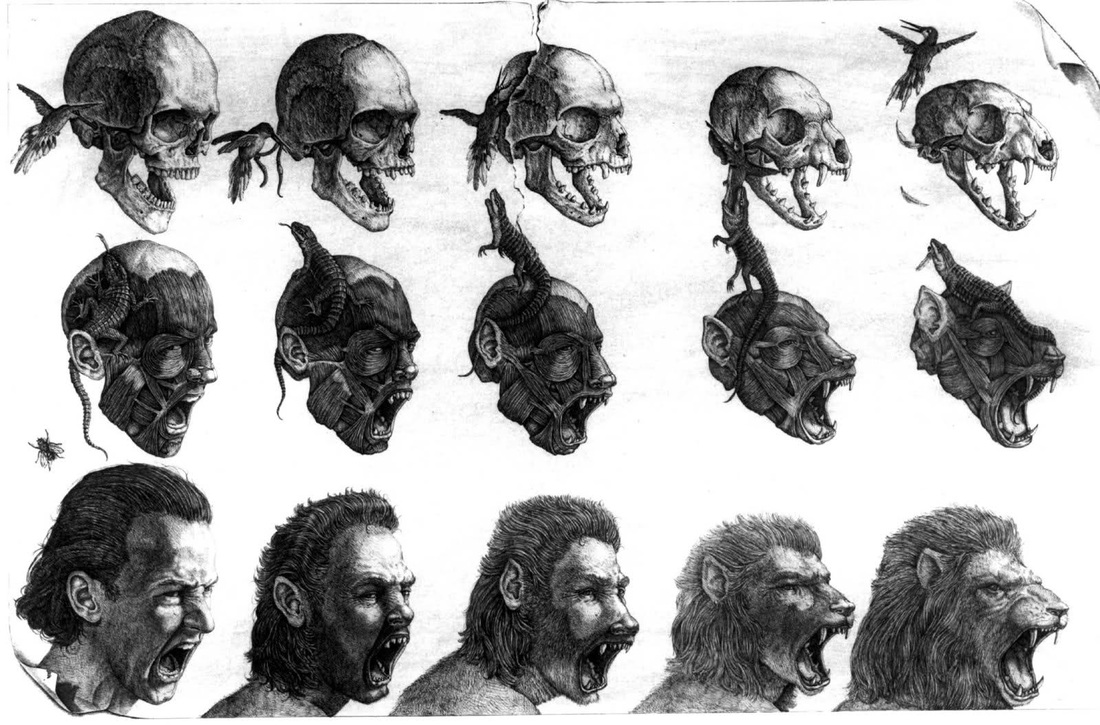Transformation
Project Description: Humans have always been enamored with the thought of being an animal. Our myths and legends have us transforming into animals all the time; Beauty and the Beast, Werewolves, Were rabbits, the princess swan, The Frog prince, etc. The Greek gods also frequently took animal form in myths. The other end of this spectrum is physiognomy, or the science of the countenance (facial features), wherein, people say we look like animals. Several portraits have reflected this concept. Your project is to combine these two concepts. Take your face and transform it to the face of an animal showing the process of the transformation in five (5) steps. Those five steps will be five individual artworks that will be put together in a book form.
Essential Questions: Why are people so enraptured by the thought of being an animal? Why do people imply animal features to other people (i.e. people look like their pets)? How can drawing explain the need for humans to identify with being animals?
Activity 1: Research Physiognomy and transformation myths. Write your findings in your sketchbook along with your observations of different people and faces.
read Activity 7
Activity 2: Sketch your own face several times from different angles using a mirror. Sketch your face using a photograph.
Activity 3: Look up and sketch your favorite animal. concentrate on the face of the animal. sketch it from many different angles (remember that sketching is a quick assemblage of ideas and NOT a finished drawing).
Activity 4: Pick your favorite sketch of your face and your favorite sketch of your animal. try and imagine the three stages in between these two pictures and how they would happen. start sketching the sequence in between.
Activity 5: Show your progression to a classmate and get a critique of your sketches. Have your sketches approved by the instructor and determine with which of the tools you have studied in the course of the year with which you would like to make the book (you may use one material/technique on the interior and another on the covers).
Activity 6: Proceed to make the final product checking in with the instructor as you go.
Activity 7: Take progress shots of your work as it comes together. Create a slide show of your transformation on Google Slides!
Essential Questions: Why are people so enraptured by the thought of being an animal? Why do people imply animal features to other people (i.e. people look like their pets)? How can drawing explain the need for humans to identify with being animals?
Activity 1: Research Physiognomy and transformation myths. Write your findings in your sketchbook along with your observations of different people and faces.
read Activity 7
Activity 2: Sketch your own face several times from different angles using a mirror. Sketch your face using a photograph.
Activity 3: Look up and sketch your favorite animal. concentrate on the face of the animal. sketch it from many different angles (remember that sketching is a quick assemblage of ideas and NOT a finished drawing).
Activity 4: Pick your favorite sketch of your face and your favorite sketch of your animal. try and imagine the three stages in between these two pictures and how they would happen. start sketching the sequence in between.
Activity 5: Show your progression to a classmate and get a critique of your sketches. Have your sketches approved by the instructor and determine with which of the tools you have studied in the course of the year with which you would like to make the book (you may use one material/technique on the interior and another on the covers).
Activity 6: Proceed to make the final product checking in with the instructor as you go.
Activity 7: Take progress shots of your work as it comes together. Create a slide show of your transformation on Google Slides!
|
Your browser does not support viewing this document. Click here to download the document.
Physiognamy |
transformation |






